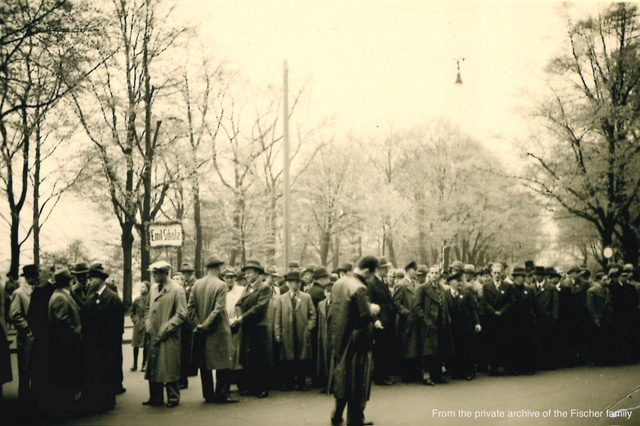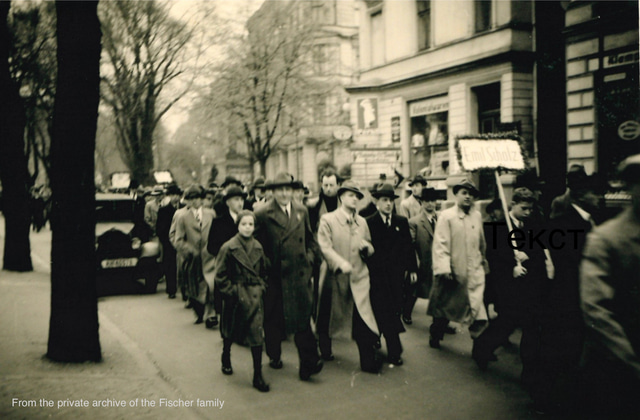


In the photographs from the private archive of the Fischer family, one can see the employees of the Emil Scholz factory in Hamburg on May 1, 1937, among whom is Kurt Fischer — the future founder of the Fischer company, who at that time worked for Emil Scholz.
The company Emil Scholz was founded in Hamburg in the second half of the 19th century by entrepreneur Emil Clemens Ephraim Scholz as a business specializing in optical and meteorological instruments. Although the exact founding date is not recorded in available sources, by 1880 the firm was already known as a manufacturer of scientific and measuring instruments — a product catalogue from that year has survived. According to it, the company specialized in “optischen und meteorologischen Waaren” (“optical and meteorological goods”) and was located at Admiralitätsstraße 11, in the center of the city. The product range included barometers, hygrometers, thermometers, telescopes, levels, and other instruments valued both in science and in everyday use. Thanks to the quality of its products, the company earned the trust of customers in Hamburg — a major port and commercial hub. It quickly became a recognized name among suppliers of precision optics and meteorological equipment.
After the death of Emil Scholz in 1887, the business was for a time managed by his widow — Cayetana Augustina Scholz (née Pereira). She continued her husband’s work under the same company name, striving to preserve its reputation and clientele. However, it soon became clear that the firm needed a new director with strategic vision.
«Emil Scholz. This firm has revoked the power of attorney granted to Detlef Asmuns Nicolay Carstensen. Emil Scholz.The business previously operated under this firm by Cayetana Augustina, née Pereira, widow of Emil Clemens Ephraim Scholz, has been taken over by Johann Heinrich Ludwig Deis and Konrad Barthold Heinrich Schimmelpfeng and will be continued by them as sole proprietors, under the unchanged firm name.» — Amtsblatt der freien und Hansestadt Hamburg (Beiblatt). 1889. № 231. October 3, 1889. P. 1574. (Section "Oeffentlicher Anzeiger").
In 1889, ownership of the company was officially transferred to Johann Heinrich Ludwig Deis and Conrad Barthold Heinrich Schimmelpfeng, as recorded in the Hamburger Börsenhalle announcement dated October 1, 1889. The company retained the name Emil Scholz, but from that point onward, a new chapter began — the Scholz-Schimmelpfeng era.
Heinrich Schimmelpfeng became the de facto leader of the firm (initially alongside Deis). While Deis had commercial experience, he remained involved only briefly and died in 1900.
Heinrich Schimmelpfeng (1867–1947) was born in Hersfeld and received commercial training at a bank in Kassel. After his apprenticeship, he moved to Berlin and then to Hamburg, intending to use the Hanseatic city as a springboard for an international career. However, fate took a different turn. Offered the opportunity to head the Emil Scholz company, he accepted — and threw himself into the work with enthusiasm.
In 1890, he invited his younger brother Hermann Schimmelpfeng to join the business. The brothers proved to be a highly effective team. They modernized the manufacturing process, optimized logistics, and were quick to respond to growing demand — especially for aneroid barometers, which were in high demand in the late 19th century. Orders grew so substantially that the brothers were able to begin producing their own movements, greatly increasing their independence and profit margins.
New production facilities were needed, and the business temporarily moved to Bohnenstraße. However, those premises soon became insufficient as well.
By 1914, the company had the capacity to build its own production facility at Marschnerstraße 11–13, in the Barmbek district. A steel engraving of the new factory appeared on company letterheads of the time — a proud symbol of permanence and ambition.
It was also during this period that the firm introduced its official logo: a white horse leaping leftward in front of the rising sun, superimposed on a square-grid globe. This striking image — a metaphor for energy, speed, and global reach — became a trademark of Scholz-Schimmelpfeng quality.
While the company mainly focused on barometers and hygrometers, it also manufactured related instruments such as thermometers, clocks, psychrometers, and recording devices. It maintained strong ties with scientific institutions and maritime services.
As industrialization progressed, demand for measurement and control instruments increased. The company successfully competed in the national market and likely exported part of its production abroad. Heinrich Schimmelpfeng managed the firm’s finances with skill, reinvesting profits into production expansion. By the 1910s, Emil Scholz had become not only a legacy family firm but also a modern precision instrument factory in Hamburg. Technical literature from the time noted its use of advanced materials — for example, instead of traditional wood or metal, the company introduced a proprietary synthetic resin known as “Festellan” for thermometer casings.
«Room thermometers in barometer form are manufactured by the firm Emil Scholz, Hamburg, Marschnerstraße 11–13; for the casings of the thermometers, we use our own synthetic resin ‘Festellan’.» — Die Umschau. Illustrierte Wochenschrift über die Fortschritte in Wissenschaft und Technik, ed. Prof. Dr. J. H. Bechhold, Frankfurt a. M., Heft 10, March 4, 1934, p. 1574.
When the First World War broke out in 1914, Emil Scholz was at a high point. War brought new opportunities: the firm began fulfilling military contracts, especially for the rapidly expanding air force and artillery sectors. Around 1916, Emil Scholz was producing aviation altimeters with ranges up to 8000 meters for the German Air Force. These were installed in airplanes and observation balloons, making the firm a key supplier of aviation instrumentation in wartime Hamburg. Military orders ensured full production capacity and cash flow, although under heavy state control.
After the war, the company faced serious challenges. Germany’s defeat and the Treaty of Versailles (1919) sharply curtailed aviation and arms production. Demand for aviation instruments collapsed, and Emil Scholz had to shift to civilian goods. In the aftermath of war, hyperinflation (1923) and economic upheaval, the company survived by adapting. It returned to producing meteorological and industrial instruments, and entered a new niche — time-tracking systems, such as factory punch clocks. Its precision expertise also allowed it to offer repair and calibration services for existing instruments, which became an important revenue stream. Despite hardship, the firm weathered the crises of the Weimar Republic.
Meanwhile, Heinrich’s brother Hermann Schimmelpfeng fell ill and withdrew from the business. Left alone, Heinrich carried on managing the company. In 1925, his son Ferdinand Rudolf Schimmelpfeng (1899–1981) joined the firm after completing his technical education. By 1933, he became a co-owner, and the company again became a father-and-son partnership.
During the 1930s, Scholz-Schimmelpfeng focused on in-house innovations — new housing designs, simplified mechanisms, and modern materials. These moves helped offset declining military demand and opened up new markets in science, technology, and even architecture (e.g. meteorological stations in schools and hospitals). With the outbreak of World War II in 1939, Emil Scholz was again integrated into the military economy of the Third Reich. Its Hamburg factory produced aeronautical instruments in series, including altimeters, thermometers, barometers, cockpit clocks, and related equipment. By 1941, the firm was officially designated as a Flugzeug-Bordgerätewerk (“Aircraft Onboard Equipment Factory”).
During the war, demand surged and labor shortages followed. Archival evidence shows the company hired additional watchmakers and mechanics, including disabled war veterans, to assemble high-precision instruments — testimony to the workload and the strategic importance of the firm.
Financially, the firm thrived during the war thanks to steady government contracts, although it was fully subordinate to military authorities. Yet war also brought devastation. Hamburg was heavily bombed, especially during Operation Gomorrah in July 1943. The Barmbek district — where the Emil Scholz factory was located — suffered serious damage. It is likely that the factory buildings were at least partially destroyed. Even when intact, production was frequently halted by air raids. By 1945, the city’s infrastructure lay in ruins, and the company’s operations had essentially ceased.
Resuming normal business after the war proved difficult. First, the Allied occupation authorities prohibited the production of aviation-related equipment. Second, the factory required significant investment to be rebuilt.
Heinrich Schimmelpfeng died in 1947, leaving not only a shuttered factory but a monumental challenge for his son — to rebuild in a ruined nation.
Despite all obstacles, Ferdinand Rudolf Schimmelpfeng refused to give up. He focused on export markets, particularly for civilian-use barometers and precision instruments. His business instincts and the enduring quality of Scholz products helped restore the brand’s international standing — especially in Western Europe and the United States, where the company became known as a producer of finely crafted wall barometers in traditional German style.
But by the 1970s, the economic landscape had changed. Cheap imports from Asia, shifting consumer tastes, and the retirement of old-generation craftsmen all played their part. In 1974, the firm — then owned solely by Rudolf Schimmelpfeng — officially ceased operations. The story of Emil Scholz is a remarkable example of a family-owned company that managed to adapt to the dramatic historical upheavals of the 20th century. It survived two world wars, hyperinflation, technological transformation, and generational change, leaving behind a significant legacy.
Scholz barometers and altimeters still surface in private collections and museums, silent reminders of the technical mastery and entrepreneurial tenacity of German instrument makers from the late 19th to mid-20th century.